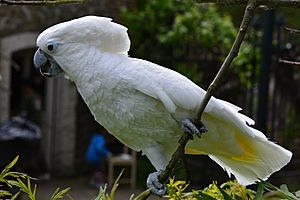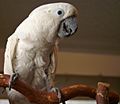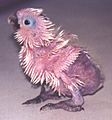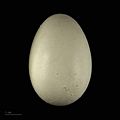White cockatoo facts for kids
Quick facts for kids White cockatoo |
|
|---|---|
 |
|
| At Pairi Daiza, Belgium | |
| Conservation status | |
| Scientific classification | |
| Genus: |
Cacatua
|
| Species: |
alba
|
The white cockatoo (Cacatua alba), also called the umbrella cockatoo, is a beautiful, medium-sized white bird. It lives in the tropical rainforests on islands in Indonesia. When this cockatoo is surprised, it raises a large, striking crest of feathers on its head. This crest looks like a semicircle, much like an umbrella, which is how it got its other name.
When they fly, you can see pale yellow or lemon colors on their wings and tail. White cockatoos look similar to other white cockatoo species. However, those other species have yellow, orange, or pink crest feathers instead of white ones.
Contents
Names
In the Burmeso language of Papua, Indonesia, the white cockatoo is called ayab. If there are many of them, they are called ayot.
About the White Cockatoo
The white cockatoo was first described in 1776 by a German scientist named Philipp Ludwig Statius Müller. Its scientific name, alba, comes from a Latin word meaning "white". It belongs to a group of birds called Cacatua, which is part of the larger Cacatua genus.
Even though white cockatoos are sometimes called "white parrots," they are not considered "true parrots" by scientists. Cockatoos and true parrots are related, but they belong to different bird families.
What White Cockatoos Look Like
A white cockatoo is usually about 46 centimeters (18 inches) long. Females can weigh around 400 grams (14 ounces), while larger males can weigh up to 800 grams (28 ounces). Males often have a wider head and a bigger beak than females.
These birds have dark gray beaks and brown or black eyes. When female white cockatoos grow up, their eyes can sometimes turn reddish-brown. Adult males keep their dark brown or black eyes.
Most of the white cockatoo's feathers are white. However, the inner parts of their large wing and tail feathers are yellow. This yellow color is most noticeable on the underside of their wings when they fly. Short white feathers also cover their upper legs.
Like other cockatoos and parrots, white cockatoos have special feet called zygodactyl feet. This means they have two toes pointing forward and two toes pointing backward. This helps them hold objects with one foot while standing on the other, which is useful for eating and playing.
In zoos, white cockatoos can live for 40 to 60 years. Some people say they can live even longer. In the wild, they are thought to live about ten years less.
Where White Cockatoos Live
The Cacatua alba lives only in the lowland tropical rainforests of the Moluccan islands in North Maluku, Indonesia. These islands include Halmahera, Bacan, Ternate, Tidore, Kasiruta, and Mandioli. Some white cockatoos have also been introduced to places like Taiwan.
They live in different types of forests, including untouched forests, forests that have been logged, and new forests that are growing back. They can also be found in mangrove swamps and on farms, including coconut plantations.
Even though they are still common in some areas, their numbers are going down quickly. This is mainly because many are caught for the pet trade.
Behavior and Life Cycle
Reproduction
Like all cockatoos, white cockatoos build their nests inside hollows of large trees. Their eggs are white, and usually, a female lays two eggs at a time. Both the male and female take turns sitting on the eggs for about 28 days until they hatch.
When the chicks hatch, the bigger chick often gets more food than the smaller one. The young birds leave the nest about 84 days after hatching. They become fully independent about 15 to 18 weeks later. Young white cockatoos are ready to have their own babies when they are 3 to 4 years old.
When a male cockatoo wants to attract a female, he ruffles his feathers, spreads his tail and wings, and raises his crest. Then he bounces around. At first, the female might ignore him. But if she likes him, she will let him get closer. If she accepts him, the pair will preen each other's heads and scratch each other's tails. This helps them form a strong bond. When they are ready to mate, the male will mount the female. For pairs that are already bonded, this process is much quicker. Once they are ready to nest, the breeding pair will leave their group to find a good tree hollow for their nest.
Feeding
In the wild, white cockatoos eat berries, seeds, nuts, fruits, and roots. When they are nesting, they also eat insects and their larvae. They especially like fruits like papaya, durian, langsat, and rambutan.
Sometimes, they eat corn from fields, which can cause problems for farmers. They also eat large insects like crickets and small lizards such as skinks. Cockatoos kept as pets usually eat a special mix of seeds, nuts, and dried fruits. They also need fresh vegetables, fruits, and branches to chew on.
Conservation Status
The white cockatoo is listed as an Endangered bird by the IUCN. This means their numbers in the wild have dropped a lot. The main reasons for this decline are being caught for the pet bird trade and losing their natural homes.
The white cockatoo is protected by CITES Appendix II. This means there are rules to control how many can be exported and imported. Even though fewer birds are officially taken from the wild now, illegal trade still happens. Many white cockatoos are still caught illegally and sold, especially in Indonesia and the Philippines. This illegal trade breaks Indonesian wildlife laws.
History
White cockatoos were very popular in China during the Tang dynasty. They even influenced how the goddess Guan Yin was shown, often with a white parrot. In 1229, a white cockatoo was given as a gift to the Sultan of Babylon by Holy Roman Emperor Frederick II. This gift helped seal an agreement during the Fourth Crusade.
Gallery
See also
 In Spanish: Cacatúa blanca para niños
In Spanish: Cacatúa blanca para niños










